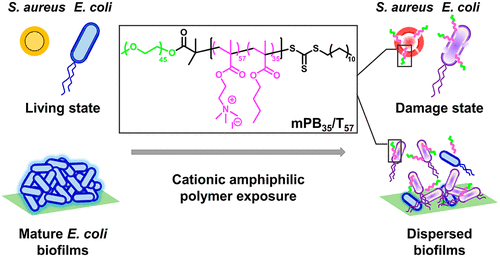当前位置:
X-MOL 学术
›
Biomacromolecules
›
论文详情
Our official English website, www.x-mol.net, welcomes your
feedback! (Note: you will need to create a separate account there.)
Screening and Matching Amphiphilic Cationic Polymers for Efficient Antibiosis
Biomacromolecules ( IF 5.5 ) Pub Date : 2020-11-23 , DOI: 10.1021/acs.biomac.0c01330 Shuyue Zhao 1, 2 , Wenjun Huang 1, 2 , Changrong Wang 1, 2 , Yaping Wang 1 , YuFeng Zhang 1 , Zhanpeng Ye 1 , Jianhua Zhang 1 , Liandong Deng 1 , Anjie Dong 1, 2
Biomacromolecules ( IF 5.5 ) Pub Date : 2020-11-23 , DOI: 10.1021/acs.biomac.0c01330 Shuyue Zhao 1, 2 , Wenjun Huang 1, 2 , Changrong Wang 1, 2 , Yaping Wang 1 , YuFeng Zhang 1 , Zhanpeng Ye 1 , Jianhua Zhang 1 , Liandong Deng 1 , Anjie Dong 1, 2
Affiliation

|
The amphiphilic cationic polymers that mimic antimicrobial peptides have received increasing attention due to their excellent antibacterial activity. However, the relationship between the structure of cationic polymers and its antibacterial effect remains unclear. In our current work, a series of PEG blocked amphiphilic cationic polymers composed of hydrophobic alkyl-modified and quaternary ammonium salt (QAS) moieties have been prepared. The structure–antibacterial activity relationship of these cationic polymers was investigated against E. coli and S. aureus, including PEGylation, random structure, molecular weights, and the content and lengths of the hydrophobic alkyl side chains. The results indicated that PEGylated random amphiphilic cationic copolymer (mPB35/T57) showed stronger antibacterial activity and better biocompatibility than the random copolymer without PEG (PB33/T56). Furthermore, mPB35/T57 with appropriate mole fraction of alkyl side chains (falkyl = 0.38), degree of polymerization (DP = 92), and four-carbon hydrophobic alkyl moieties was found to have the optimal structure that revealed the best antibacterial activities against both E. coli (MIC = 8 μg/mL, selectivity > 250) and S. aureus (MIC = 4 μg/mL, selectivity > 500). More importantly, mPB35/T57 could effectively eradicate E. coli biofilms by killing the bacteria embedded in the biofilms. Therefore, the structure of mPB35/T57 provided valuable information for improving the antibacterial activity of cationic polymers.
中文翻译:

筛选和匹配用于高效抗菌的两亲阳离子聚合物
模仿抗菌肽的两亲性阳离子聚合物由于其出色的抗菌活性而受到越来越多的关注。但是,阳离子聚合物的结构与其抗菌效果之间的关系仍然不清楚。在我们目前的工作中,已经制备了一系列由疏水性烷基改性和季铵盐(QAS)部分组成的PEG封闭的两亲阳离子聚合物。研究了这些阳离子聚合物对大肠杆菌和金黄色葡萄球菌的结构-抗菌活性关系,包括聚乙二醇化,无规结构,分子量以及疏水性烷基侧链的含量和长度。结果表明,聚乙二醇化无规两亲阳离子共聚物(mPB 35/ T 57)比没有PEG(PB 33 / T 56)的无规共聚物表现出更强的抗菌活性和更好的生物相容性。此外,发现具有适当摩尔分数的烷基侧链(f烷基= 0.38),聚合度(DP = 92)和四碳疏水烷基部分的mPB 35 / T 57具有最佳的结构,具有最佳的抗菌性。对大肠杆菌(MIC = 8μg/ mL,选择性> 250)和金黄色葡萄球菌(MIC = 4μg/ mL,选择性> 500)均具有活性。更重要的是,mPB 35 / T 57可以有效根除大肠杆菌通过杀死生物膜中嵌入的细菌来杀死生物膜。因此,mPB 35 / T 57的结构为改善阳离子聚合物的抗菌活性提供了有价值的信息。
更新日期:2020-12-14
中文翻译:

筛选和匹配用于高效抗菌的两亲阳离子聚合物
模仿抗菌肽的两亲性阳离子聚合物由于其出色的抗菌活性而受到越来越多的关注。但是,阳离子聚合物的结构与其抗菌效果之间的关系仍然不清楚。在我们目前的工作中,已经制备了一系列由疏水性烷基改性和季铵盐(QAS)部分组成的PEG封闭的两亲阳离子聚合物。研究了这些阳离子聚合物对大肠杆菌和金黄色葡萄球菌的结构-抗菌活性关系,包括聚乙二醇化,无规结构,分子量以及疏水性烷基侧链的含量和长度。结果表明,聚乙二醇化无规两亲阳离子共聚物(mPB 35/ T 57)比没有PEG(PB 33 / T 56)的无规共聚物表现出更强的抗菌活性和更好的生物相容性。此外,发现具有适当摩尔分数的烷基侧链(f烷基= 0.38),聚合度(DP = 92)和四碳疏水烷基部分的mPB 35 / T 57具有最佳的结构,具有最佳的抗菌性。对大肠杆菌(MIC = 8μg/ mL,选择性> 250)和金黄色葡萄球菌(MIC = 4μg/ mL,选择性> 500)均具有活性。更重要的是,mPB 35 / T 57可以有效根除大肠杆菌通过杀死生物膜中嵌入的细菌来杀死生物膜。因此,mPB 35 / T 57的结构为改善阳离子聚合物的抗菌活性提供了有价值的信息。











































 京公网安备 11010802027423号
京公网安备 11010802027423号